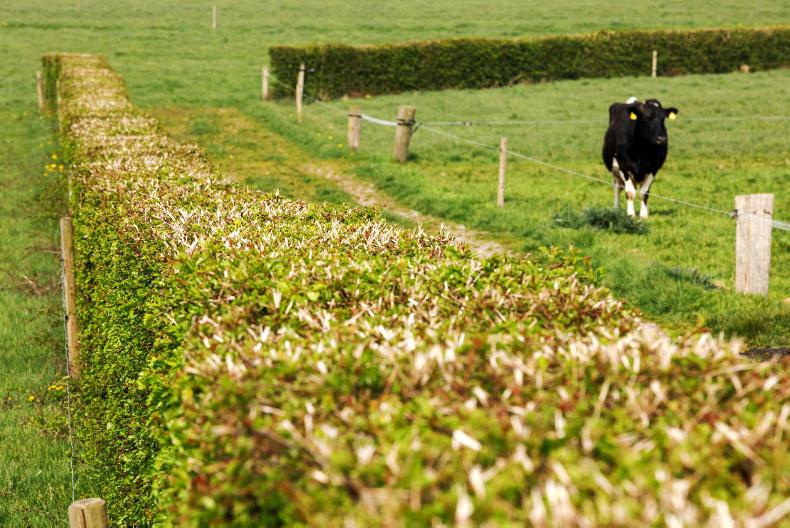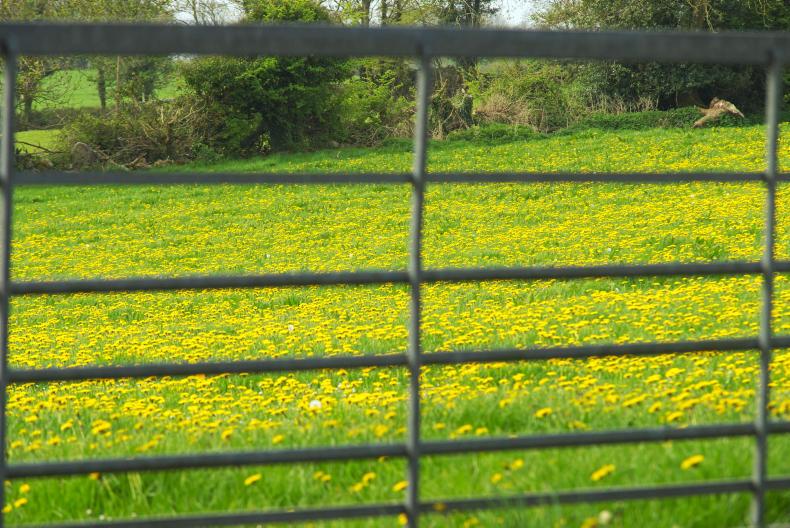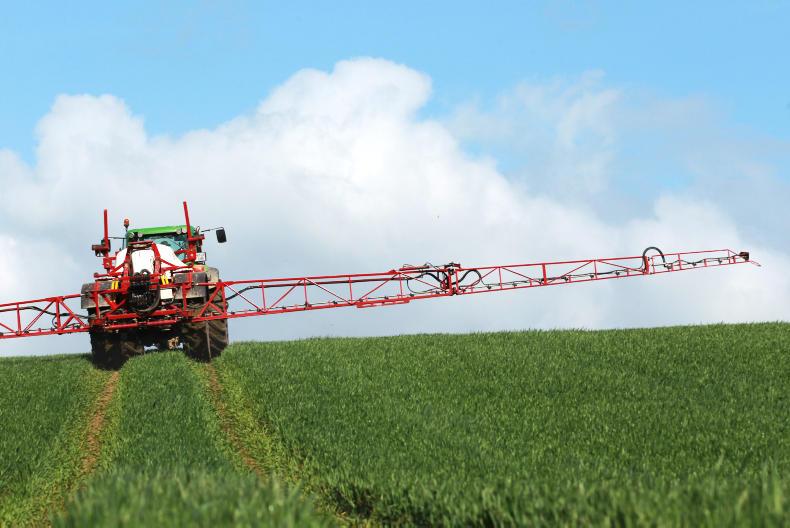The EU could cut pesticide use on farms by 50% by 2030 under the EU’s biodiversity strategy, the Irish Farmers Journal can reveal.
A draft copy of the strategy shows that the EU will commit to “reduce the risk and use of pesticides by 50% in the EU and drastically increase the uptake of integrated pest management methods and biocontrols” by 2030.
The Farm to Fork strategy, rather than the biodiversity strategy, is to address the reduction in the use of pesticides and will look at measures, such as legislation and CAP tools, to meet that aim.
The biodiversity strategy shows that the EU commits to increase the uptake of “agroecological practices” and ensure that at least 30% of farm land is under organic farming.
It is not clear whether this means the whole of the EU or whether each member state would need to have 30% of organic land.
In order to ensure this commitment is delivered on, the Commission will adopt an action plan on organic farming, which will include measures to stimulate the consumption of organic products, for example green public procurement.
The draft strategy also says the EU will commit:
To place at least 10% of farm land under non-productive and landscape features.To maintain and enhance high-nature-value farmland.To stop the deterioration of farmland birds and wild pollinator populations and show gradual improvement.To increase conservation and sustainable use of genetic agro-biodiversity and the knowledge and use of genetic pools.The EU will also commit “to cover at least 30% of both EU land and sea area by a network of effectively and equitably managed, as well as ecologically representative, protected areas and/or other area-based effective conservation measures.
“They will be legally protected, covering the most important areas for biodiversity including Natura 2000 sites and other designated areas.”

Compensation
Through each member state’s CAP strategic plans, the Commission will promote the uptake of EU funds for the creation of landscape features and for compensating farmers for the maintenance of non-productive areas.
“This includes setting out a new facilitated payment under the CAP to small farm areas (similar to the one hectare initiative) producing particularly valuable ecosystem services, such as water retention, flood and soil erosion control, biodiversity shelter and connectivity.
“The Commission has proposed in the CAP proposal that any conversion of ploughing of permanent grassland in Natura protected areas will be banned.
“The LIFE programme will also be mobilised for that purpose. The Commission will engage with member states on a methodology to define and map high-nature-value farmland and make guidelines on the best management practices which could then be used for management plans and for the design of interventions under the CAP,” it says.
Targets for tree planting
Forests are “a key piece of the puzzle to solve the climate and biodiversity crisis”, according to the draft strategy.
“The EU must improve EU’s forests in quantity and quality, preserving and enhancing forest biodiversity and restoring degraded forests and their ecosystem services.
“Enhancing the state of forest ecosystems will necessarily entail an increase in the area of sustainably managed forests, including applying closer to nature forestry principles fostering a higher species diversity and minimising clear cuts harvesting.”
Under the strategy, the EU will commit to plant millions of trees per year. The target for planting is blank in the draft seen by the Irish Farmers Journal.
These trees will be planted in urban areas, current forests and agroecosystems.
The Commission will adopt an EU forest strategy “which will have as key objective effective afforestation, forest preservation and restoration to Europe”.

Trade agreements
The Commission will assess the impact of trade on biodiversity, specifically new and existing trade agreements.
“The Commission will more thoroughly assess the impact of trade on biodiversity, based on a specific methodology to be developed by 2021.
“It will fully implement and enforce the sustainable development chapters of trade agreements, including with the future EU chief trade enforcement officer,” it said.
Other measures
Other measures under the draft plan include to achieve land degradation neutrality in the EU and in terms of protecting freshwater sources, there will be measures to cover the reduction of pollutants into freshwater.
The report highlights agriculture here and says this will include the “phasing out of subsidies or incentives negatively affecting freshwater ecosystems”.
Read more
Bord Bia puts farm sustainability programme on hold for two months
Fertiliser and pesticide targets blank in EU Farm to Fork plan
Teagasc planting kilometres of hedgerows on its farms
The EU could cut pesticide use on farms by 50% by 2030 under the EU’s biodiversity strategy, the Irish Farmers Journal can reveal.
A draft copy of the strategy shows that the EU will commit to “reduce the risk and use of pesticides by 50% in the EU and drastically increase the uptake of integrated pest management methods and biocontrols” by 2030.
The Farm to Fork strategy, rather than the biodiversity strategy, is to address the reduction in the use of pesticides and will look at measures, such as legislation and CAP tools, to meet that aim.
The biodiversity strategy shows that the EU commits to increase the uptake of “agroecological practices” and ensure that at least 30% of farm land is under organic farming.
It is not clear whether this means the whole of the EU or whether each member state would need to have 30% of organic land.
In order to ensure this commitment is delivered on, the Commission will adopt an action plan on organic farming, which will include measures to stimulate the consumption of organic products, for example green public procurement.
The draft strategy also says the EU will commit:
To place at least 10% of farm land under non-productive and landscape features.To maintain and enhance high-nature-value farmland.To stop the deterioration of farmland birds and wild pollinator populations and show gradual improvement.To increase conservation and sustainable use of genetic agro-biodiversity and the knowledge and use of genetic pools.The EU will also commit “to cover at least 30% of both EU land and sea area by a network of effectively and equitably managed, as well as ecologically representative, protected areas and/or other area-based effective conservation measures.
“They will be legally protected, covering the most important areas for biodiversity including Natura 2000 sites and other designated areas.”

Compensation
Through each member state’s CAP strategic plans, the Commission will promote the uptake of EU funds for the creation of landscape features and for compensating farmers for the maintenance of non-productive areas.
“This includes setting out a new facilitated payment under the CAP to small farm areas (similar to the one hectare initiative) producing particularly valuable ecosystem services, such as water retention, flood and soil erosion control, biodiversity shelter and connectivity.
“The Commission has proposed in the CAP proposal that any conversion of ploughing of permanent grassland in Natura protected areas will be banned.
“The LIFE programme will also be mobilised for that purpose. The Commission will engage with member states on a methodology to define and map high-nature-value farmland and make guidelines on the best management practices which could then be used for management plans and for the design of interventions under the CAP,” it says.
Targets for tree planting
Forests are “a key piece of the puzzle to solve the climate and biodiversity crisis”, according to the draft strategy.
“The EU must improve EU’s forests in quantity and quality, preserving and enhancing forest biodiversity and restoring degraded forests and their ecosystem services.
“Enhancing the state of forest ecosystems will necessarily entail an increase in the area of sustainably managed forests, including applying closer to nature forestry principles fostering a higher species diversity and minimising clear cuts harvesting.”
Under the strategy, the EU will commit to plant millions of trees per year. The target for planting is blank in the draft seen by the Irish Farmers Journal.
These trees will be planted in urban areas, current forests and agroecosystems.
The Commission will adopt an EU forest strategy “which will have as key objective effective afforestation, forest preservation and restoration to Europe”.

Trade agreements
The Commission will assess the impact of trade on biodiversity, specifically new and existing trade agreements.
“The Commission will more thoroughly assess the impact of trade on biodiversity, based on a specific methodology to be developed by 2021.
“It will fully implement and enforce the sustainable development chapters of trade agreements, including with the future EU chief trade enforcement officer,” it said.
Other measures
Other measures under the draft plan include to achieve land degradation neutrality in the EU and in terms of protecting freshwater sources, there will be measures to cover the reduction of pollutants into freshwater.
The report highlights agriculture here and says this will include the “phasing out of subsidies or incentives negatively affecting freshwater ecosystems”.
Read more
Bord Bia puts farm sustainability programme on hold for two months
Fertiliser and pesticide targets blank in EU Farm to Fork plan
Teagasc planting kilometres of hedgerows on its farms








 This is a subscriber-only article
This is a subscriber-only article










SHARING OPTIONS: